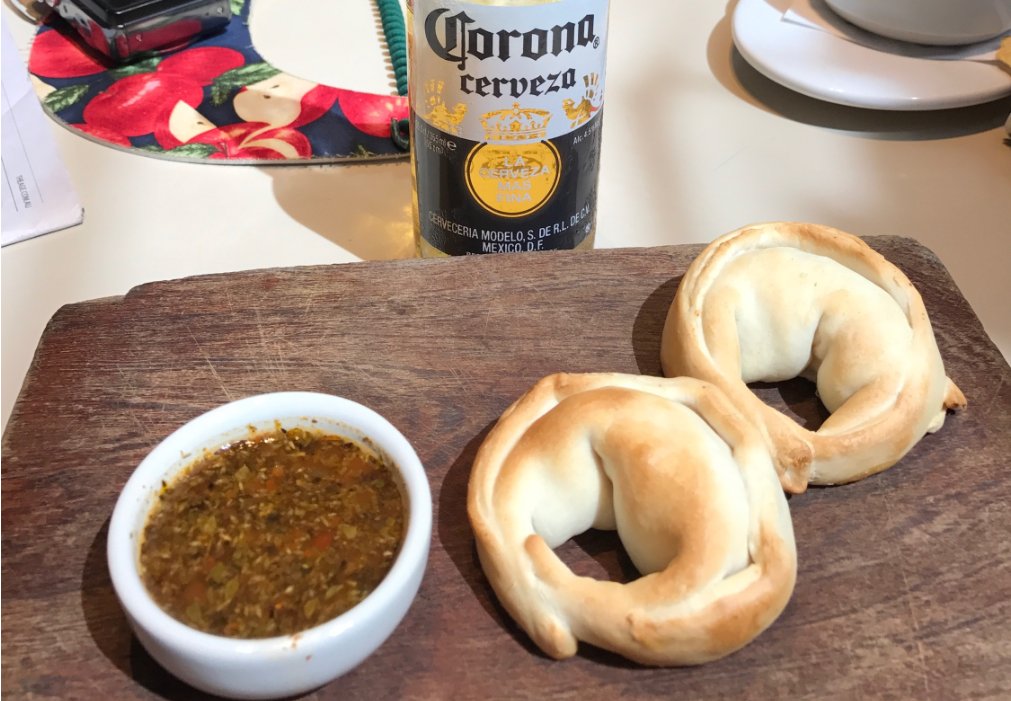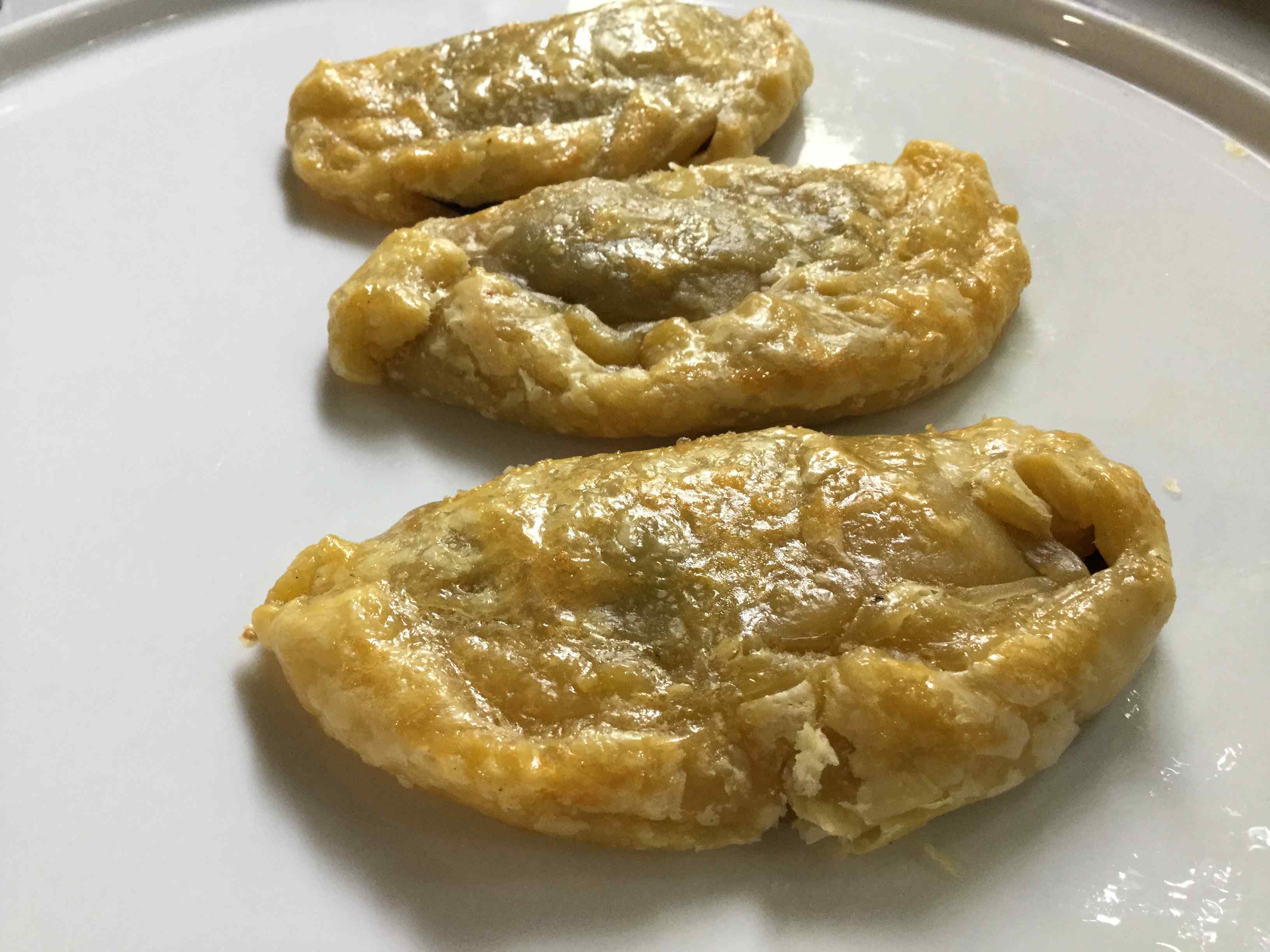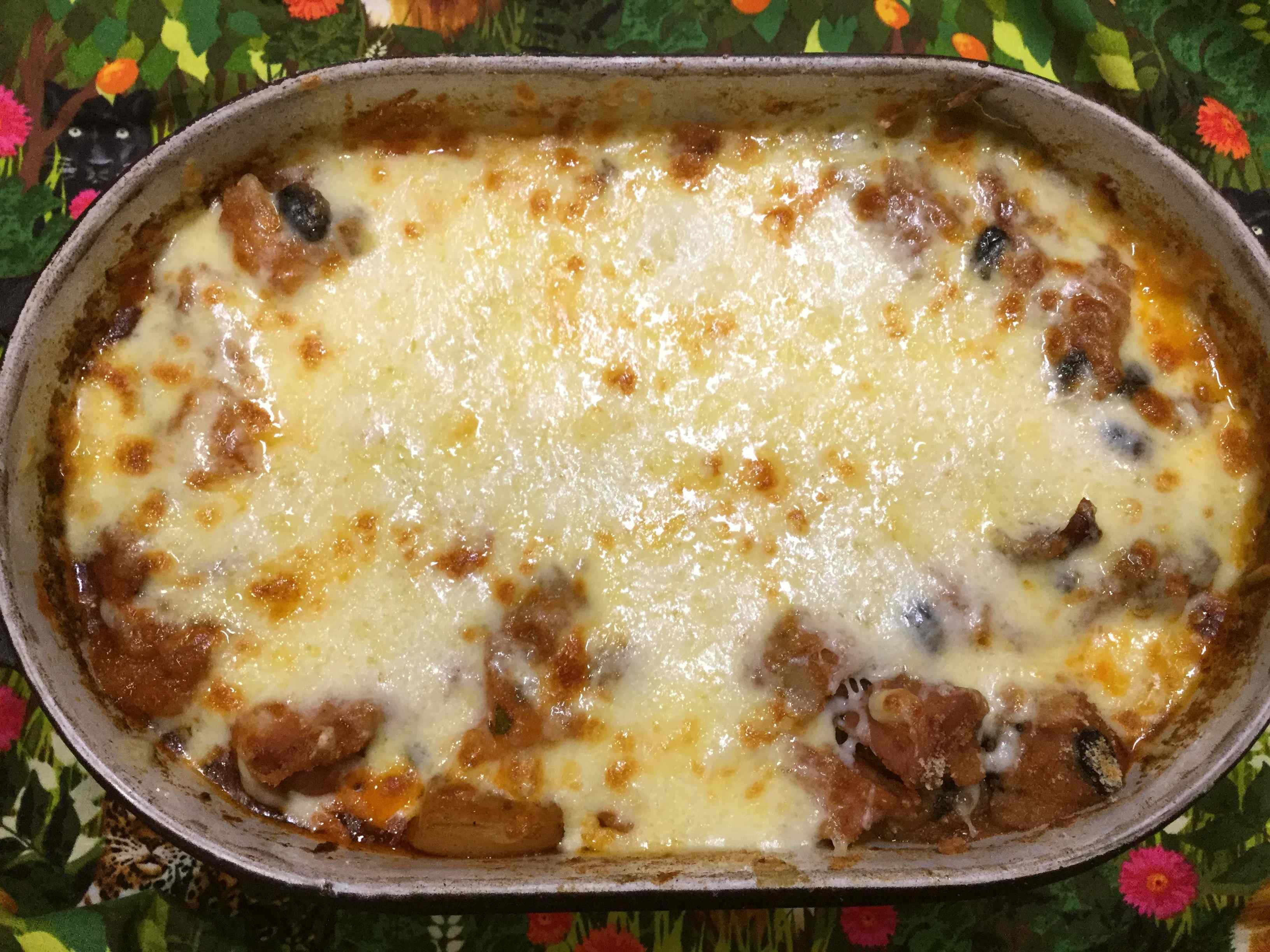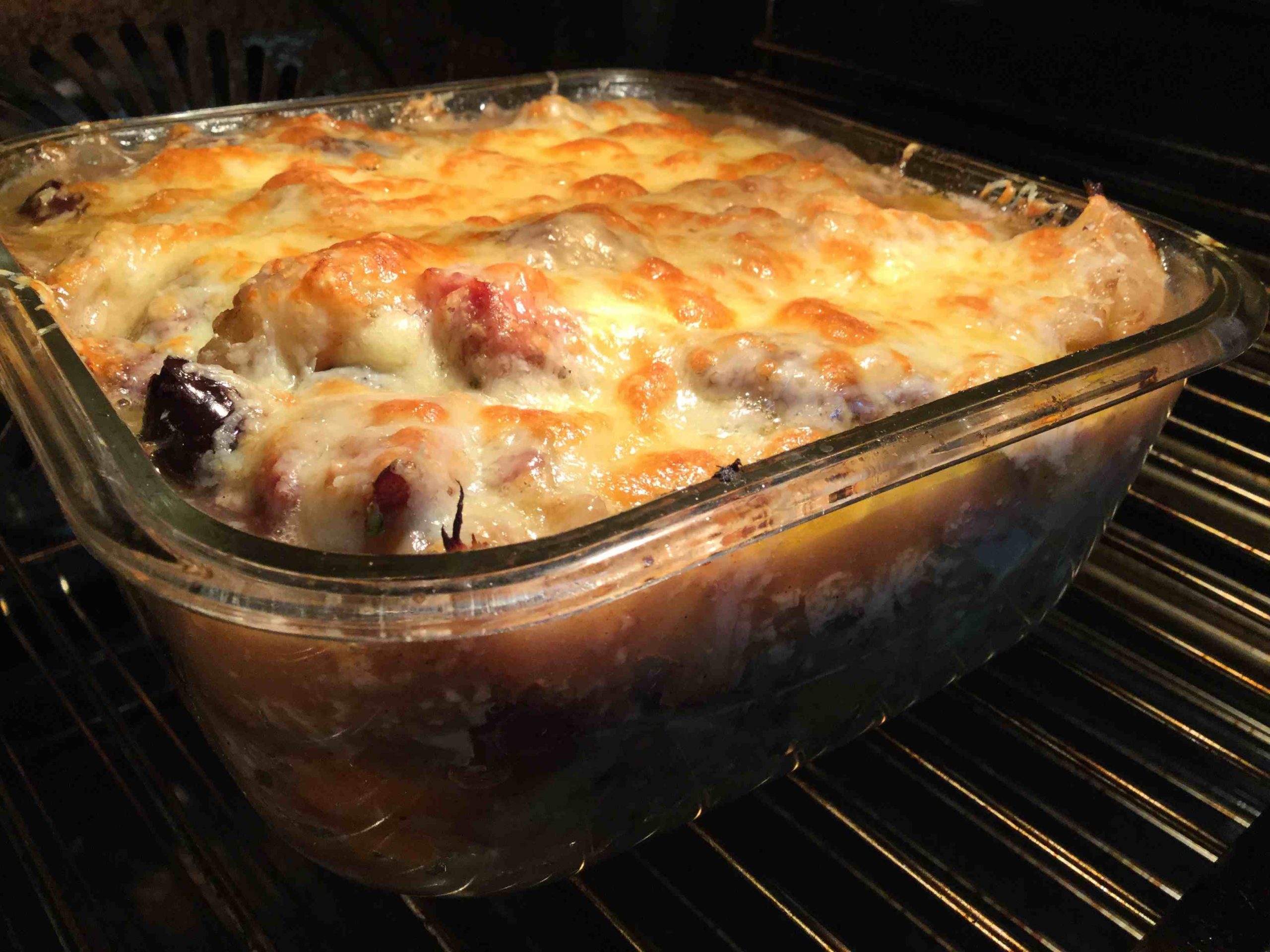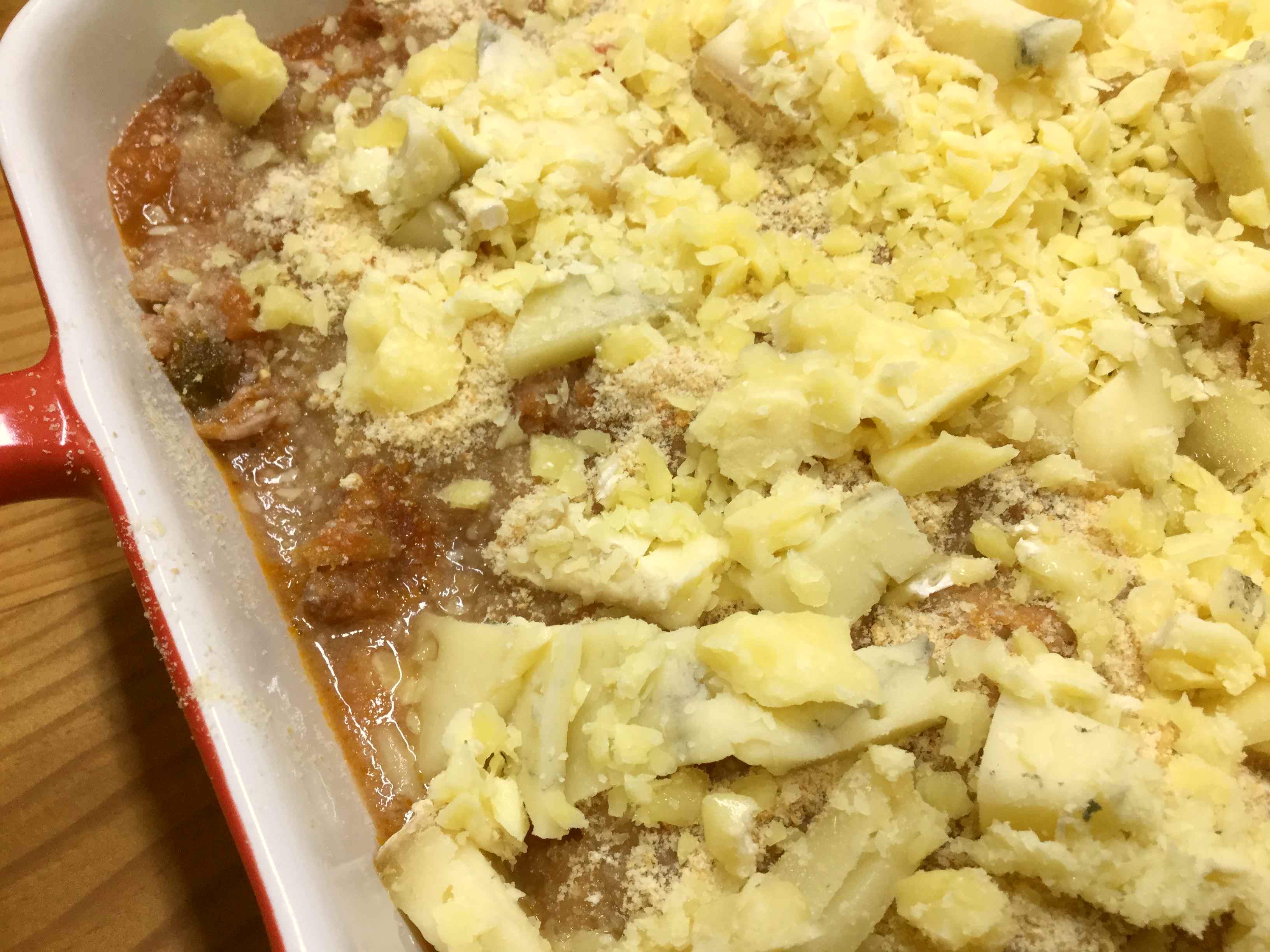This post follows on from: Buenos Aires – The Food!
In this post we give two recipes inspired by what we ate in Argentina. However, they are as much methods as they are recipes, meaning you can use them as guides to your own versions. Our recipes are not traditional by any means but hopefully you will enjoy them if you give them a go.
Empanadas
Empanadas are pastry parcels with all sorts of fillings. They come in different sizes, are made from different pastries and can be cooked in different ways. They are sold everywhere in Argentina (and neighbouring countries) and are the equivalent of the pie, pastie or sausage roll in Australia. The following photo gives you an idea as to how traditional ones look.
And less traditional.
If you want some guidance as to how to make the real thing, see: “How to make empanadas“.
Otherwise, here are some other ideas similar to making pastry turnovers. The method we give here assumes you have the dough ready-made or in the freezer. Make your own favourite pastry or use bought puff pastry sheets.
Bought pastry sheets give you a good example of the size as you can make four empanadas from each sheet. Use a bowl or jar with the right circumference to cut out four equal circles from each corner. These circles are quite adequate for a good sized empanada. (Reuse the scraps at a later stage for something else.) If the pastry becomes too soft while working with it, pop it back in the fridge or freezer to firm up. If you are using homemade pastry, cut into circles as described above. (If you aren’t fussed about the shape, use squares, rather than circles, and avoid leftover pastry bits.)
Make your own filling – see cookbooks or the Internet for versions from Argentina, Uruguay and other South American countries. There are many options, such as cooked minced or chopped meat (beef, lamb, chicken, etc) or ham with cheese sauce, tuna and cheese, etc. Leftovers of many kinds might work, for example, leftover Argentinean stew or even leftover Aussie stew, or thickened Indian or Thai curry. In the photograph below, for the filling, we used braised leek and mushroom with some mild blue cheese stirred through. We used bought butter puff pastry, which, while giving a delicious result, is possibly too delicate.
If the mixture is too runny, the empanada will be difficult to put together due to leakage, and the pastry may become soggy. You only need a tablespoon or so of filling, otherwise the empanadas will be too difficult to close.
Method:
- Have your filling ready. Turn the oven to 200oC.
- Prepare your circles or squares.
- Separate one egg. Retain the yolk. Whisk the white briskly with a fork – use it for sealing the empanadas. (Later, any leftover white can be added back with the egg yolk to give an egg wash for the pastry.)
- With baking trays or pizza trays ready, oil the surfaces or dust with plenty of flour to stop the empanadas from sticking, or line with baking paper.
- To make each empanada, take a circle (or square) of pastry. Place a tablespoon or so of mixture on one half – you will soon work out the right amount, whether it is too little or too much. Wet the edges of the pastry with some egg white. Fold the other half over the mixture, and fold or crimp the two sides of pastry together to seal firmly. Place on baking tray.
- When all empanadas are ready, beat together the leftover egg white and egg yolk, and brush some on the top of each empanada. Prick the top of each empanada with a pointy knife to let steam escape. They can be left to sit for 15 to 20 minutes if the pastry has not become soggy.
- Bake for 12 to 15 minutes, until the empanadas are puffed and browned.
Equipment: Baking tray.
Difficulty: Not difficult (2/5), 15 minutes preparation, 15 minutes cooking.
Serve: Serve hot or slightly cooled.
Cazuelas – Argentinean Stews!
A surprisingly delicious and reasonably common dish in South America is the cazuela, a hot pot type of dish based around the Spanish word for casserole or cooking pot. We first tried these in restaurant Cumana in Buenos Aires in 2009 and returned for more this trip. The restaurant has several choices on their menu. We give our version of the dish here. Again treat it as much a method for a dish of your own making rather than a fixed recipe.
The first photo below is from Cumana. The next two are of our versions with a cheesy topping.
Most of the ingredients for this type of hot pot stew are flexible and optional. They can contain meat or you can make a vegetarian version. The cheese makes them quite delicious as do smoky ham and salami type meats.
Vary the meat between smoky ham, shredded cooked chicken or chicken pieces or smoked chicken, pieces of chopped salami or prosciutto, Kassler, sausage, etc. If the meat is raw, for example, cubes of lamb, fry it first in the oil to sear, then set aside and add later.
Choose between different types of beans (soaked white or black beans, or canned beans), lentils or chick peas. (A tin of baked beans in tomato sauce is a cheat, but works well.) You can instead use a tin of beans for thickening the stew towards the end: strain it, then mash the beans well, then stir through.
Select the vegetables as required: sweet potato, pumpkin, potato, celeriac, parsnip, Jerusalem artichokes, fresh spinach, etc.
The cheese is optional, but really adds to the dish. Choose between what is available such as cheddar, gruyere, parmesan, mozzarella or provolone.
Your cazuela can be prepared the day before to give it more flavour. Add the cheese half an hour before serving.
Use the ingredients and method given below to create your own version: it could range from a minimalist one to one where you throw in everything. Halve the ingredients below for fewer people; or freeze any leftovers.
Ingredients
Stew base:
- 2 tbsps olive oil, butter, lard or duck fat
- 1 large onion, chopped
- 1-2 medium sticks of celery chopped
- 1-2 medium carrots chopped
- 4 cloves garlic chopped or crushed
- 1 tbsp sweet red paprika
- 400-600 g chopped tomatoes, or equivalent tinned
Meat:
- 500-700 g cooked meat or meat pieces as described above
Stock and herbs:
- 300 ml litre or so of chicken stock or equivalent
- 250 ml white wine
- 2 bay leaves
- 1-2 tbsps chopped fresh herbs such as oregano or thyme
- 1-2 tbsps chopped fresh parsley
- 1 small hot chilli chopped (optional)
- cayenne pepper
- salt and pepper to taste
Vegetables:
Select from the following:
- 2 cups of chick peas, beans or green lentils (tinned, or soaked and cooked)
- 2 to 3 cups of sweet potato, pumpkin, potato, etc., cubed
- 1 green or red or yellow capsicum chopped and/or yellow squash or zucchini
- 1 cup sweet corn kernels and/or peas (fresh or frozen)
- 500 g or so of baby spinach leaves, washed
To finish:
- water or more stock as required
- breadcrumbs (optional)
- 2 cups grated cheese (mixture of different varieties, ensuring that at least one has a reasonably strong flavour, for example, parmesan or gruyere)
Method
In a large saucepan or heavy casserole, heat the oil and then add and fry in turn the onion, celery and carrot. Add the garlic, but do not burn, then stir through the paprika to colour.
Add the tomatoes. Stir through the meat pieces. Add the stock, wine and herbs and spices and bring to a simmer. Add the chick peas or equivalent. Simmer covered.
After 30 minutes or so, add the remaining vegetables in stages to cook, with the sweet potato, pumpkin or potato first. Then the capsicum. (Leave the corn, peas and spinach until towards the end, see below.) There should be enough liquid to just cover the meat and vegetables.
Turn off and leave for some hours or overnight.
About 20 to 30 minutes before serving turn the oven to 180oC or be ready to turn on the griller. Reheat the stew on the stove top. Add more water or stock if required. Add the corn, peas and spinach at this stage if using. You don’t want the stew to be too runny, nor too gluggy. Heat through gently. Thicken with some breadcrumbs stirred through (or flour or tin of beans) if necessary.
When thoroughly heated, transfer to one or more ovenproof serving dishes.
Sprinkle the cheese over the top. Do not stir it in.
Place in the oven uncovered to allow the cheese to melt slowly. (Or place under the griller but not too hot). Serve at the table.
Equipment: Large saucepan or casserole for the stove top. Large or small casserole dishes for the oven.
Difficulty: Moderately difficult (3/5), 30 minutes preparation, one to two hours cooking.
Serve: Serve immediately, perhaps with crusty bread. Serves six as main course.
Click here for the next stage in our South American journey: Four weeks in Patagonia, Atacama & Mendoza



